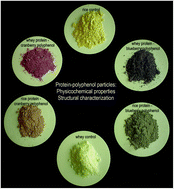Formulation of protein–polyphenol particles for applications in food systems
Abstract
Consumers are demanding healthy nutritious foods rich in protein (both plant and animal) and biologically-active phytochemicals from plants, which can help the body to sustain a stronger immune system and fight against oxidative stress. The aim of this study was to determine the conditions required to enhance the concentration of bioactive phenolics and protein in aggregate particles formed with whey or rice protein isolates and polyphenol-rich berry juices (cranberry and blueberry), and to evaluate properties associated with food structural functionality and stability. Different protein concentrations (10, 15 and 20% w/w) and mixing durations were tested in order to study their effects on particle formation. Addition of juices significantly increased the aggregation of whey proteins in suspensions at pH 4.5, resulting in a trimodal distribution of protein–polyphenol particles: sizes at 5 μm, 30 μm, and above 100 μm. However, the addition of polyphenol-rich juices did not markedly alter aggregation or particle size distribution for rice proteins, as compared to rice protein particles formed with imitation juice. The particles formed with 10% w/w whey protein and blueberry juice yielded the highest total phenolic (27 mg g−1 particle) and protein content (805 mg g−1 particle); therefore, only 25 g of protein–polyphenol particles delivered simultaneously 20 g of protein, and the equivalent blueberry polyphenols (∼0.64 g total polyphenolics) in two servings (150 g) of blueberries. Particles formed with whey protein and blueberry juice significantly improved foam stability and drainage half-life. Protein–polyphenol particles can be designed as ingredients to stabilize food structures and to increase delivery of health protective polyphenols and proteins in the diet.

- This article is part of the themed collection: Berry Health Benefits Symposium


 Please wait while we load your content...
Please wait while we load your content...